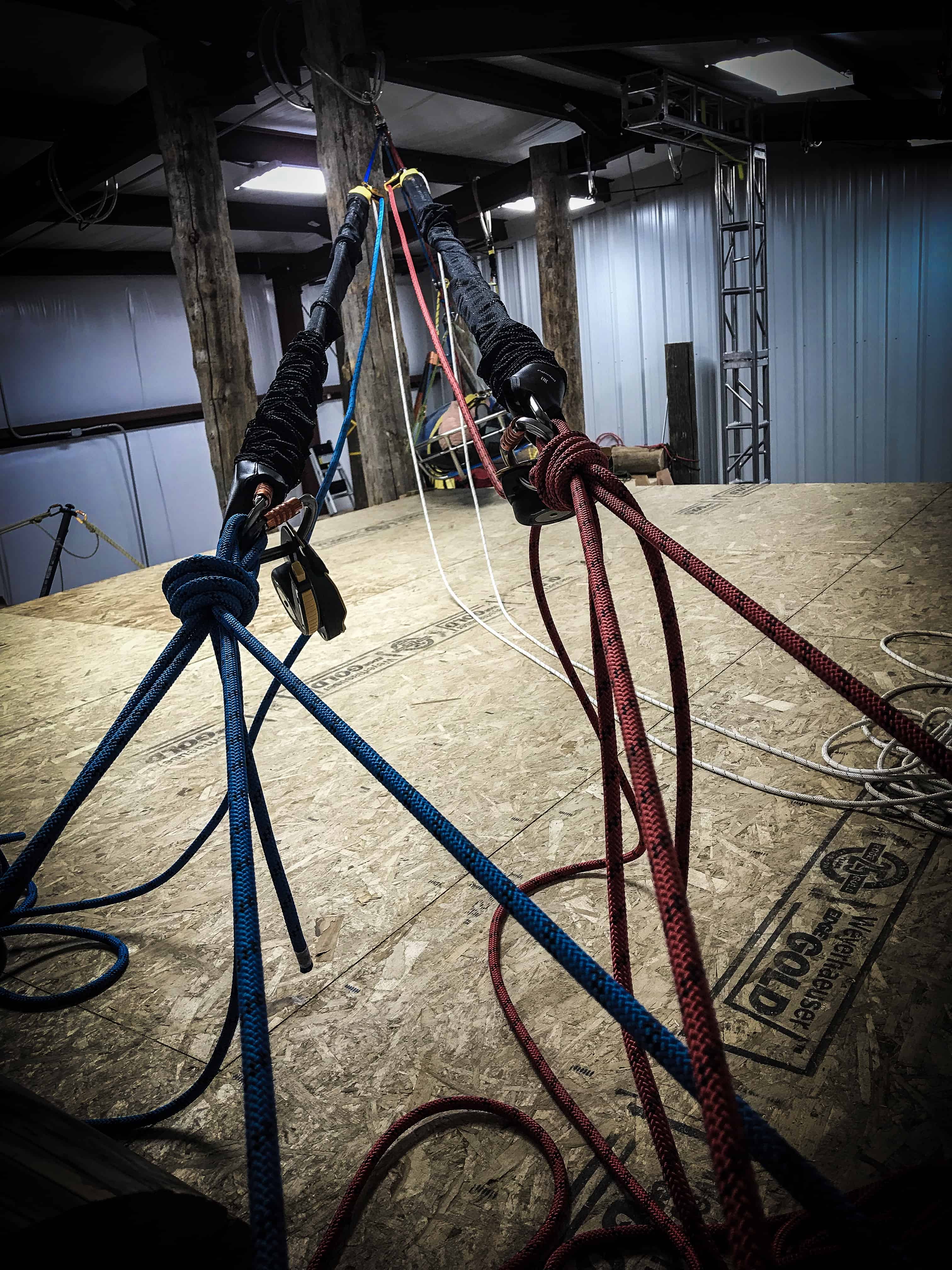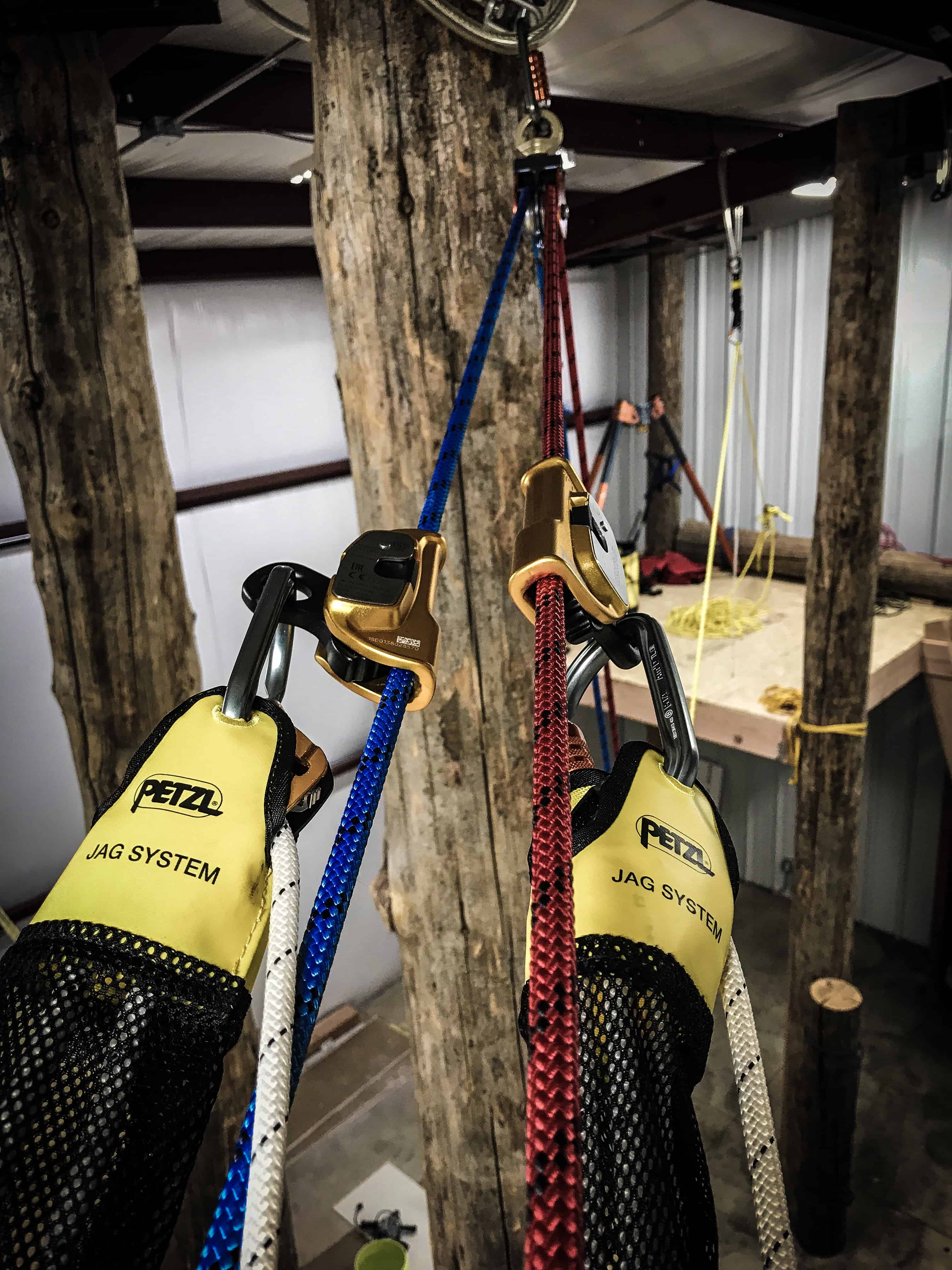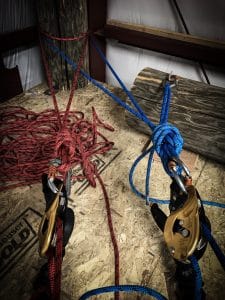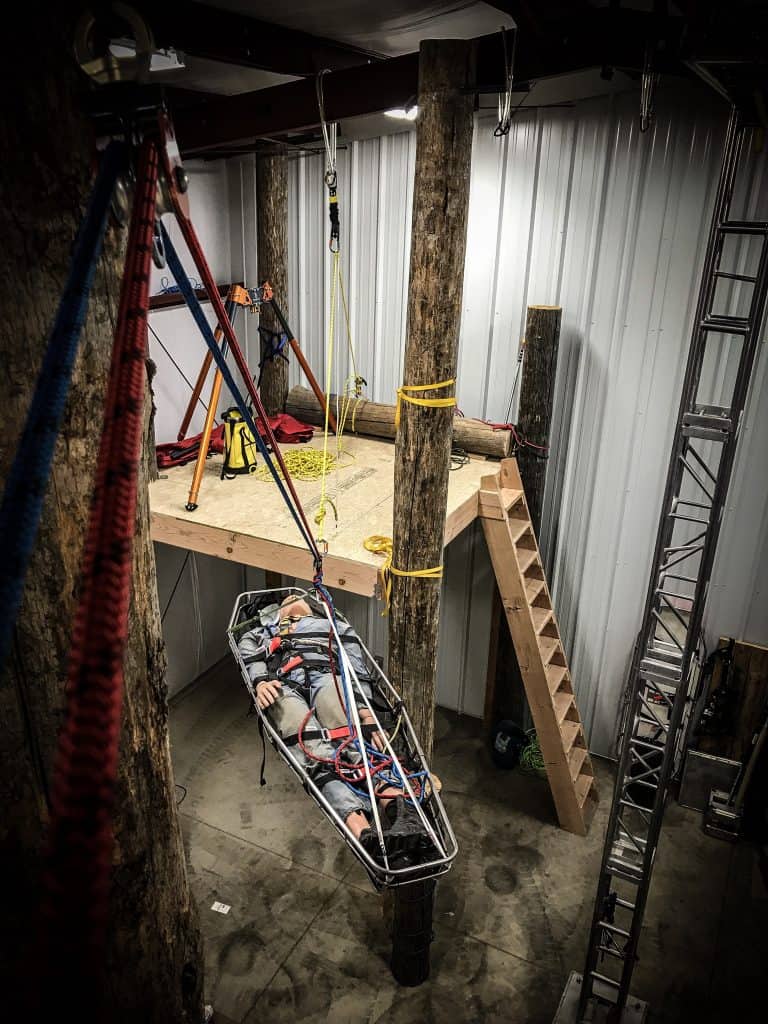 What to learning something well?… “Do it yourself “. Well, this isn’t always the case, but for me (right now) it is. While not obsessed, I am really curious as to what a true minimally viable raise and lower system looks and feels like. Remember the 3 types of learning?….. Vision, Auditory and Kinesthetic. Well, this is my “kinesthetic” journey.
What to learning something well?… “Do it yourself “. Well, this isn’t always the case, but for me (right now) it is. While not obsessed, I am really curious as to what a true minimally viable raise and lower system looks and feels like. Remember the 3 types of learning?….. Vision, Auditory and Kinesthetic. Well, this is my “kinesthetic” journey.
The Dual Capacity or Twin Tension ropes systems have the same function and work in parallel. They either mirror each other or at least, very similar in function to each other and we’ll be building examples of these “non mirrored twin tension or dual capacity rope systems in future blogs.
The simple purpose of this journey is to actually “feel system”. I am not, at this point, interested in data analytics, using load cells to determine safety factors or going out of my way to create a “best practice” scenario. I am simply building systems that fit within a semi narrow scope of purpose and build several variations of each one to simply see and feel the system in my hands. Meaning, I am running the entire operation alone.
Yes, the systems might get a bit clumsy at certain points and I might make minor adjustments here and there just to see what it feels like.
Now, you might be catching a key phrase here… “feels like”. The reason for this is quite basic; running a system and “feeling a system” are not the same. Running a large capacity system with 6 people is nowhere near as intimate as running the entire thing on your own.
You might be asking, “why in the world would someone attempt to run both near and far sides alone”? Well, great question. I am creating an MVP or minimal viable project. I am not interested in how other people feel about these systems. I alone am the only person I am interested in and the reason for this (too) is basic. I need to be able to feeling the system’s (efficiencies or lack of) and the work that goes into making a truly minimal viable project… minimal. Meaning, how far can I get before I get ridiculous and when I get to a point where things are actually making more sense, I will start adding the load cells and start the data analysis.
Considerations I have with building Twin (Two) Tension (Dual Capacity) Rope Systems with Litter Operations
- With good coordination, it’s possible to haul a heavy load even with simple systems.
- If one rope breaks, the other is already tensioned to hold the load, reducing the amount of clearance required.
- It is possible to manage a complex litter route if the rope paths are anticipated.
- Load sharing between the two ropes is never perfect; sometimes one rope holds the entire load; good coordination of team members is required.
- Both ropes are tensioned and so lessens the susceptibility to failures.
- Load sharing may lessen overall need for bomber anchors.
 Why Now: Never before in rope rescue has the two-tension rope system been so accessible to reap the benefits from it. This is largely in part because of devices like the MPD becoming commonplace across the country. By using devices such as the Petzl ID or the CMC MPD, the operator is able to operate a rope system with an auto stopping feature. This allows for much greater control over the descent of a load than ever before. It also allows two operators to work side by side, and communicate easily to lower a load at the same rate of speed by using like devices.
Why Now: Never before in rope rescue has the two-tension rope system been so accessible to reap the benefits from it. This is largely in part because of devices like the MPD becoming commonplace across the country. By using devices such as the Petzl ID or the CMC MPD, the operator is able to operate a rope system with an auto stopping feature. This allows for much greater control over the descent of a load than ever before. It also allows two operators to work side by side, and communicate easily to lower a load at the same rate of speed by using like devices.
The two-tensioned rope system decreases this fall distance substantially. Due to the fact that both lines are sharing tension, should one fail there is a greatly diminished slam factor on to the remaining line because that line is already carrying 50% of the load (ideally). If we were to incorporate load cells in to both ropes in a two-tensioned system, it would be rare that at all times both are receiving exactly half the load, but even a small amount of tensioned introduced in to a second rope will aid in cutting fall distance. The CMC MPD is a perfect device to be used for this application because in the literature for the product it lists the capability to support a full rescue load. This means, that if both devices for a two-tensioned system are MPDs, and one were to fail, the surviving MPD will be capable of receiving the entirety of the load.
Another benefit of a two-tensioned system using a device such as the MPD is the simplicity of lowering, and raising. Because the MPD is not only a descent control device with auto stopping functionality, but also a full efficiency pulley, it has never been easier to transition from a lowering operation to a raising operation and back again.
The two-tensioned rope system has been tested and proven to perform better in many circumstances than a dedicated main dedicated belay rope system. Safety is improved, efficiency is increased, and training is simplified. It is the best practice of Rigging Lab Academy to teach the two-tensioned rope system as the predominant method to conduct our operations.
Shout Outs…
- Petzl I’d Petzl’s popular ID, short for industrial descender, is quickly becoming a must have for tech rescue and rope access professionals. Its versatility, safety and smooth action make the ID indispensable for personal positioning, system tensioning, belaying and much more.
- Petzl Jag System Haul kit for pickoffs, making a releasable anchor, or tensioning a system, thanks to its 4:1 mechanical advantage and excellent efficiency (sheaves with sealed ball bearings).
- Petzl Axis Static kernmantel rope for todays demanding rope work. The 11mm (7/16) AXIS line of rope from Petzl features innovative design that helps maintain the ropes shape, while giving the rope a great handle for knotcraft.
- Petzl Rescucender Openable cam-loaded rope clamp. Simple to use and ergonomic, the RESCUCENDER is an openable cam-loaded rope clamp designed for use in haul systems as a tractor or progress capture device.
- Cascade Rescue Professional Stainless Steel Litter The Cascade Rescue Professional Series STEEL Rescue Litter offers the best of all worlds. Reasonable pricing with the most advanced features of any rescue stretcher available today. Designed for the demanding professional, the litters are constructed with a 3/4 tubular frame and 3/8 supporting cross members, powder coated for extreme durability. Each litter includes Four Quick-Tab Patient Straps, integral Patient Contour Support (standard taper boards fit too) and a heavy duty high density polyethylene mesh liner.
I will continue to keep you posted on things.
Peace on your Days…
Lance










3 thoughts on “Litter Hauling Techniques Using Dual Capacity or Twin Tension Rope Systems: A Journey Part 1”
845191 626630Hi, you used to write outstanding articles, but the last several posts have been kinda lackluster I miss your super writing. Past couple of posts are just slightly out of track! 36166
985799 160843Hey There. I discovered your weblog utilizing msn. That is actually a extremely smartly written write-up. I will make positive to bookmark it and come back to read much more of your helpful information. Thanks for the post. I will definitely return. 846225
696153 371134really nice publish, i surely adore this internet site, maintain on it 566328
Comments are closed.